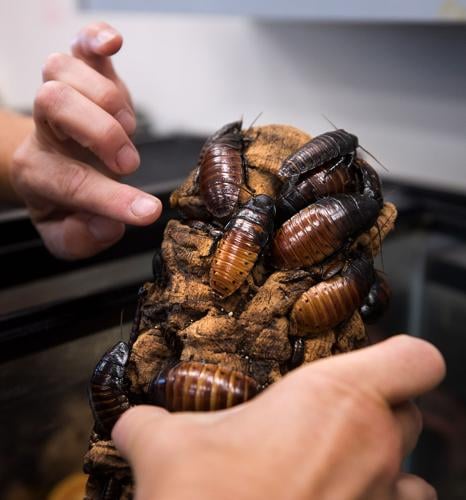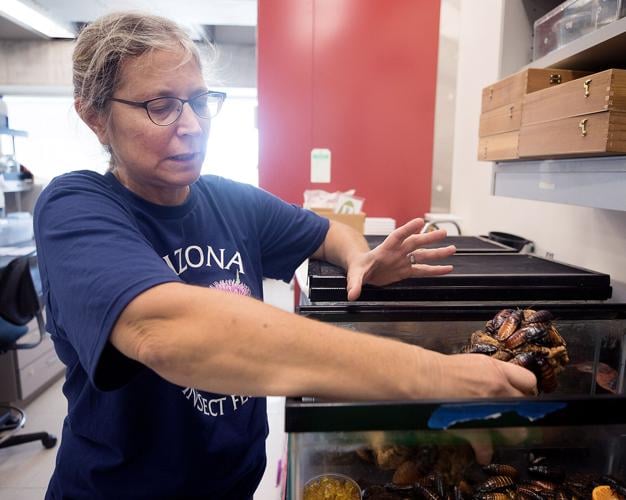Some cockroaches like to cuddle. You’re just going to have to trust Kathleen Walker about that.
The University of Arizona entomologist and educator has been working with giant Madagascar hissing cockroaches for decades now.
Walker regularly uses the harmless, easy-to-handle, brown-and-black bugs in her educational programs at local schools, and she will have a batch of them available Sunday to anyone interested in touching or holding one during the annual Arizona Insect Festival at the UA.
“They’re what we call gregarious. They live in a group, they know each other, and they all engage in brood care. It doesn’t matter if you’re male or female; it doesn’t matter if it’s your baby,” she said. “This is the thing: When you actually know about them, they’re really quite appealing little animals.”
Her creepy, crawly — and, she insists, cuddly — exhibit on “The Joy of Roaches” is one of about two dozen booths planned for the festival, which returns to action after two years of COVID cancellation.
The event will also feature other live critters and hands-on educational displays about bug brains, pollinators, poetry, insects as food and this year’s featured local critter, the white-lined sphinx moth.
Several UA departments will be represented, as will the Arizona-Sonora Desert Museum, the Southeastern Arizona Butterfly Association, Tohono Chul and others.
Walker, who helped organize the first insect fest 11 years ago, said the event was launched to get people to “appreciate these really underappreciated creatures.”

Kathleen Walker on hissing cockroaches: “They want to be in physical proximity to each other, which is something that humans do, too.”
“It’s also, hopefully, a way of getting more people interested in science,” she said.
There’s a big push this year to broaden the festival’s audience by advertising more widely in Spanish and at schools in south-side neighborhoods that have been under-represented at past events, Walker said.
A number of entomology departments at universities around the U.S. hold similar outreach events, she said, because insects are “ubiquitous but mysterious, and children especially are really interested in them.”
Walker has been keeping hissing cockroaches since she was in college. She started her colony at the UA in 2005, when she got about 10 of the wingless forest dwellers to use in her Insect Discovery educational outreach programs at local schools.
Now she has hundreds of roaches, some of them more than three inches long, living happily together in three different terrariums in her lab.
And the colony “just keeps growing and growing and growing,” she said. “Every now and then I take an enormous bunch over to Tropical Kingdom (Pet Store) and just give them to them to sell.”
Individual roaches can live three to five years, even after suffering serious trauma.
Walker’s booth this year will include a shrine to a particularly tough roach she and her son nicknamed Sparky after it escaped from its cage and hid out on the bottom of a casserole dish, only to end up in the oven. Walker rescued the bug just in time, but not before it suffered a burn scar on its back that was still visible even after it molted its exoskeleton several times.
Sparky lived another three years and produced at least three broods of babies.

Kathleen Walker, an entomologist and insect educator, holds one of her Madagascar hissing cockroaches at her lab at the University of Arizona.
“You know that whole thing about how (roaches) will survive a nuclear holocaust? Absolutely. They are just very, very resilient little creatures.”
OK, but do they really like to cuddle?
As pets go, Walker said, no one is ever going to confuse a hissing cockroach for a lap dog.
“The best thing you can say is that they tolerate humans,” she said. “They recognize me in the sense that after I’ve held them, they won’t hiss at me.”
Walker admits that calling them cuddly is just an artful way of describing the way they like to bunch together in dark places, in part to increase the humidity in the air and conserve moisture.
“They want to be in physical proximity to each other, which is something that humans do, too,” she said. So why is it considered sweet when people or kittens do it, “but it’s somehow gross in cockroaches?”
Don’t worry, Walker knows how that sounds.
“Obviously there’s an element of just being slightly ridiculous to try to get people out of their view that roaches are filth on six legs and that the only good roaches are dead roaches,” she said. “I’ve been trying to figure out what it is that people don’t like about roaches. They’ve been here for 300 million years, so if you don’t like them, you need to find another planet.”







